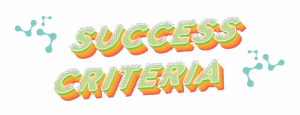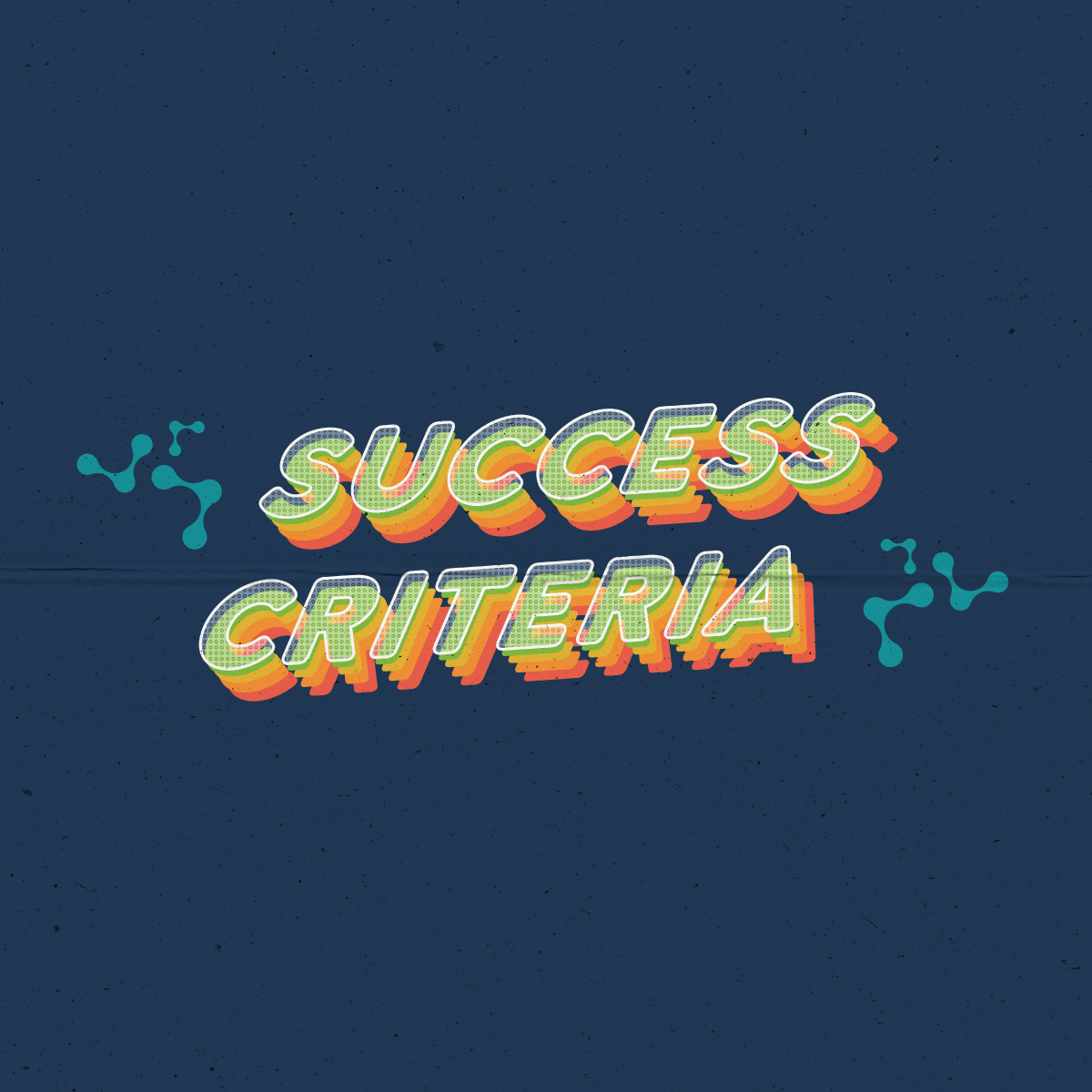If you’ve ever felt that success criteria are being overused—pasted next to every objective like wallpaper—you’re not alone. While success criteria are essential tools for clarity, feedback and metacognition, they should never become a compliance-driven checklist. When we center human connection and cultural identity, we unlock their real power: to elevate student agency, deepen learning, and foster belonging.
So, let’s ask the deeper question: Do we really need success criteria for everything?
Short answer? No.
But we do need them for the right things—especially when students are grappling with complexity, authenticity, and real-world impact.
Why Use Success Criteria at All?
Success criteria describe what “success looks like” for a specific learning goal. According to Kara Vandas and John Almarode in Clarity for Learning (2018), success criteria help students take ownership of learning when they’re clear, visible, and co-developed:
When students know what they’re learning, why they’re learning it, and what it looks like to do it well, their confidence and performance increase exponentially. (Vandas & Almarode, 2018)
They also become more assessment capable—able to answer:
- Where am I going?
- Where am I now?
- What’s next?
This aligns with John Hattie’s Visible Learning research, which finds success criteria have a high effect size (d = 0.88) when tied to metacognitive reflection and learner agency (Hattie, 2023).
What the Science Says
Success criteria clarify the standards learners should meet to successfully complete a task or reach a learning goal. They serve as explicit benchmarks against which students can measure their progress, significantly improving students’ ability to self-assess and regulate their own learning.
According to John Hattie’s extensive research synthesis, success criteria have a significant positive impact on student learning. Key points from Hattie’s work include:
- Effect Size:
- Success criteria, when explicitly articulated and consistently applied, yield a high effect size of 0.88, indicating a substantial impact on student achievement (Visible Learning, Hattie, 2012, 2015).
- This places success criteria among the most influential educational strategies, exceeding the average effect size benchmark of 0.40, which Hattie identifies as representing a year’s worth of growth for students.
- Why Success Criteria Works:
- They clarify learning intentions, reducing ambiguity and cognitive overload.
- They empower students to become assessment-capable, allowing learners to track their progress and take responsibility for their own learning.
- They facilitate more targeted and effective feedback—students understand exactly where they are, where they need to go, and what steps are necessary to bridge the gap.
Use for Transfer and Authentic Tasks
According to Dylan Wiliam, success criteria are most effective for complex tasks that require judgment and application—not as a script for every worksheet. It most likely can’t be laminated since you co-construct from examples, non-examples and students’ lived experiences.
If we overuse success criteria, students start learning to meet our expectations rather than making sense of the world. (Wiliam, 2018)
This idea is echoed in Street Data by Shane Safir and Jamila Dugan (2021), which emphasizes that educators must prioritize student voice and identity over top-down accountability. They advocate for a shift from “satellite” and “map” data to “street data,” or lived experiences—especially in how we define and assess success.
In Amplify Learner Voice through Culturally Responsive and Sustaining Assessment (Bloomberg et al., 2023), our author team stressed that success criteria are most powerful when rooted in cultural identity, student agency, and community relevance:
When success criteria reflect a student’s identity and ways of knowing, assessment becomes a liberatory act—not a limiting one. (Bloomberg et al., 2023)
Immersion Before Evaluation
For authentic, real-world tasks, students desperately need lots of examples to clarify the goal. Personally I like to do a few days of immersion where we explore lots of models in class during the co-construction process. When students are immersed in the end goal or task, they begin to form a vivid picture of what success looks like. As they analyze models of work, the criteria naturally sharpen and expand, picking up on subtle nuances of quality.
- Immersion in the end goal or task includes:
- Exposure to real-world models of excellence
- Dialogue about values, aesthetics, and purpose
- Connections to their own stories and cultures
This approach draws on cognitive apprenticeship, an instructional model in which learners develop skills through guided experiences with experts who make their thinking visible. It begins with empathy, authentic modeling, and shared creation, ensuring that learning grows from our shared humanity rather than from imposed rules. Only after trust, understanding, and collective meaning-making are established do formal criteria emerge—crafted with learners, not for them.

Asset-Based Co-Construction Framework
Here’s a 5-step framework for building success criteria that reflect identity, belonging, and rigor:
1. Start with Story and Connection
Before analyzing any examples, it’s important to first explore what “success” means to each person in the class. This step matters because ideas about success are deeply influenced by cultural values, family traditions, and personal experiences. What is considered successful in one culture or family may be different in another—ranging from academic achievement, financial stability, and career advancement to community service, family commitment, or personal happiness. By discussing the question, “What does success mean in your culture or family?”, students have the opportunity to share their unique perspectives, reflect on the values that have shaped them, and gain awareness of the diversity of worldviews in the room.
Taking time for this conversation before looking at examples not only ensures that everyone’s voice is acknowledged, but also helps create a richer, more inclusive foundation for the discussions and analyses that follow.
→ “What does success mean in your culture or family?”
→ “When have you felt most proud of something you created?”
→ “How can we create more moments like the ones you had in class?”
Begin with shared storytelling and circle prompts.
2. Analyze Examples of Strong Work
Examining pieces of strong work gives students clear examples of what quality looks like, helping them understand the standards and expectations for their own work. By studying these examples, students see effective strategies, approaches, and solutions, which guides their learning and skill development. This process shifts the focus from simply getting the right answer to understanding the steps and thinking behind successful outcomes, encouraging deeper learning and confidence.
Reviewing strong work also helps students reflect on why certain choices lead to quality results, supports improvement for all ability levels, and highlights diverse ways success can be achieved. Use real-world, AI created and/or student-created models. Ask:
→ “What makes this powerful or meaningful?”
→ Then develop:
→ “Success means I can…”
→ “My work shows…”
3. Unpack the Learning Intention with a Personal Inventory
After students have explored lots of examples of strong and even weak work I like them to reflect on at least one question from each category and then join a triad for a group dialogue. I have students chart their take aways and then each team shares with the class. We refine the criteria based on these conversations. I am also immersing them in the end goal.
Taking a personal inventory activates students’ funds of knowledge—the culturally developed skills, abilities, and knowledge they possess from daily life experiences (Moll, Amanti, González, & colleagues)—during the co-construction of success criteria. By reflecting on and sharing their lived experiences, students explicitly connect home and school, enriching the learning process and ensuring culturally responsive practices. Integrating students’ diverse backgrounds into success criteria deepens engagement, strengthens their sense of belonging, and positively influences learning outcomes.
Experience-Based Questions:
- Have I tried something similar to this before? What was my experience?
- Can I recall a moment where I succeeded at something related to this goal?
- Have I faced any similar challenges or obstacles before? How did I handle them?
Knowledge-Based Questions:
- What do I already know about this goal or topic?
- Have I read, seen, or heard anything related to this that I can draw from?
- Are there connections between this goal and other subjects or skills I’ve learned?
Identity and Value-Based Questions:
- How does this goal align with what matters to me personally?
- Why might achieving this goal be important or meaningful to me?
- What parts of my identity (e.g., interests, culture, strengths) connect to this goal?
Metacognitive and Emotional Questions:
- What feelings come up when I think about working on this goal?
- Do I feel excited, nervous, or uncertain about achieving this goal? Why?
- What beliefs do I hold about my ability to succeed with this goal?
Resource and Strategy-Based Questions:
- What strengths or skills do I already have that can help me achieve this goal?
- Who in my life (peers, family, teachers) can support me in working toward this goal?
- What strategies or approaches have helped me reach similar goals in the past?
4. Revisit and Revise
It is always important to refine success criteria as you learn more about what quality actually means because understanding deepens over time. At the start of a project or learning process, your idea of “quality” may be based on initial assumptions or limited examples. As you explore strong work, receive feedback, and gain new insights, your perspective becomes more nuanced—you begin to notice subtler qualities, higher standards, and alternative ways to achieve excellence. Continuously refining the criteria ensures that expectations stay aligned with this evolving understanding, allowing work to improve in both precision and depth. This process not only raises the bar for what’s considered “good” but also empowers learners to aim for a clearer, more authentic vision of success.
→ “Do these still feel like the right indicators of success?”
→ Allow students to adapt criteria as their understanding evolves.
When to Use Criteria vs. When to Delay |
|
| Use Success Criteria When… | Skip or Delay When… |
| Task is complex or authentic | The task is playful, exploratory, or personal. |
| Students will self-peer-assess or reflect | The task is fluency-building or reflective |
| Criteria are co-created | Students need time to immerse themselves first |
| Work will be shared beyond the classroom since it is real-world and/or required by academics. |
Informal, low rigor, or creative in nature |
Final Reflection
Success criteria aren’t about control or standardization. When used with intention, they serve as tools for liberation, feedback, and identity development. When co-constructed through dialogue and connection, they become mirrors of what students value and aspire toward—not just what we, as educators, expect.
- Let’s use success criteria to deepen meaning, not just manage learning.
- Let’s use them with students, not for students.
- Let’s ensure our definitions of success reflect both rigor and relevance—in ways that affirm who our students are and who they are becoming.
Join the Impact Team movement and help create a culture where we continuously learn, refine our vision of success, and work together to make a meaningful difference. We specialize in supporting schools that need TSI/CSI; reach out for more information.
References
- Bloomberg, P. J., Vandas, K., Twyman, I., Dukes, V., Carrillo Fairchild, R., Hamilton, C., & Wells, I. (2023). Amplify Learner Voice through Culturally Responsive and Sustaining Assessment. Mimi & Todd Press.
- Hattie, J. (2023). Visible Learning: The Sequel. Routledge.
- Safir, S., & Dugan, J. (2021). Street Data: A Next-Generation Model for Equity, Pedagogy, and School Transformation. Corwin Press.
- Vandas, K., & Almarode, J. (2018). Clarity for Learning: Five Essential Practices That Empower Students and Teachers. Corwin Press.
- Wiliam, D. (2018). Embedded Formative Assessment (2nd ed.). Solution Tree.



